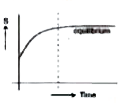Which correctly represents the entropy (s) of an isolated system during a process.




The correct Answer is:C
To determine which graph correctly represents the entropy (S) of an isolated system during a process, we need to consider the fundamental principles of thermodynamics regarding entropy changes in isolated systems.
1. Understanding Entropy in Isolated Systems:
- An isolated system is one that does not exchange energy or matter with its surroundings. It has a certain amount of entropy, which is a measure of the disorder or randomness in the system.
2. Entropy Change (ΔS):
- For any spontaneous process occurring in an isolated system, the change in entropy (ΔS) must be greater than zero. This means that the entropy of the system must increase over time as the system evolves towards equilibrium.
3. Equilibrium Condition:
- At equilibrium, the change in entropy (ΔS) becomes zero. This indicates that the system has reached a state of maximum entropy and no further spontaneous processes can occur.
4. Analyzing the Graphs:
- Graph A: Shows a decrease in entropy over time, which contradicts the principle that ΔS must be greater than zero for a process to occur.
- Graph B: (not mentioned in the transcript but assumed to be present) would need to be analyzed similarly.
- Graph C: Shows an increase in entropy over time, which aligns with the principle that for a spontaneous process, ΔS must be greater than zero. It also indicates that at equilibrium, ΔS becomes zero.
- Graph D: (not mentioned in the transcript but assumed to be present) would also need to be analyzed similarly.
5. Conclusion:
- Based on the analysis, Graph C correctly represents the entropy of an isolated system during a process. It shows an increase in entropy until equilibrium is reached, where the entropy change becomes zero.
Final Answer:
Graph C is the correct representation of the entropy of an isolated system during a process.
- An isolated system is one that does not exchange energy or matter with its surroundings. It has a certain amount of entropy, which is a measure of the disorder or randomness in the system.
- For any spontaneous process occurring in an isolated system, the change in entropy (ΔS) must be greater than zero. This means that the entropy of the system must increase over time as the system evolves towards equilibrium.
- At equilibrium, the change in entropy (ΔS) becomes zero. This indicates that the system has reached a state of maximum entropy and no further spontaneous processes can occur.
- Graph A: Shows a decrease in entropy over time, which contradicts the principle that ΔS must be greater than zero for a process to occur.
- Graph B: (not mentioned in the transcript but assumed to be present) would need to be analyzed similarly.
- Graph C: Shows an increase in entropy over time, which aligns with the principle that for a spontaneous process, ΔS must be greater than zero. It also indicates that at equilibrium, ΔS becomes zero.
- Graph D: (not mentioned in the transcript but assumed to be present) would also need to be analyzed similarly.
- Based on the analysis, Graph C correctly represents the entropy of an isolated system during a process. It shows an increase in entropy until equilibrium is reached, where the entropy change becomes zero.
Graph C is the correct representation of the entropy of an isolated system during a process.
Similar Questions
What is an isolated system ?
View SolutionDefine isolated system.
View SolutionWhich of the following sequences correctly represents the series of events that take place during sexual reproduction?
View SolutionFor an isolated system, the entropy :
View SolutionWhich of the following curves correctly represents the process of antibiotic production by Streptomyces sp ?
View SolutionWhich of the following statement (s) is correct?
Statement-I: The entropy of isolated system with P-V work only, is always maximized at equillibrium.
Statement-2: It is possible for the entropy of closed system to decrease substantialy in an irreversible process.
Statemet-3: Entropy can be crearted but not destroyed.
Statement-4 ΔSsystem is zero for reversible process in an isolated system.
View SolutionAn exothermic reaction involves a decrease in the entropy of the system. Will the process be spontaneous ?
View Solutionentropy of a system decreases
View SolutionWhich of the following correctly represents the order of atomic radii
View SolutionChoose the correct statement for an isolated system.

View Solution
